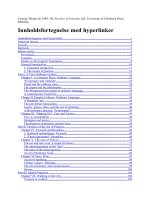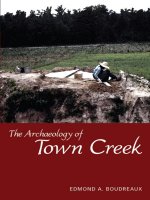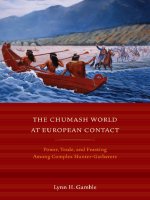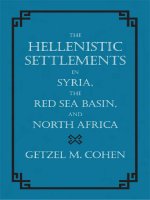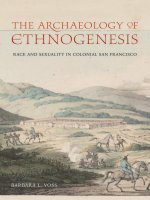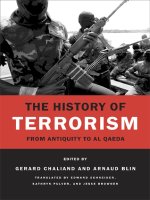university of california press the archaeology of ethnogenesis race and sexuality in colonial san francisco feb 2008
Bạn đang xem bản rút gọn của tài liệu. Xem và tải ngay bản đầy đủ của tài liệu tại đây (4.34 MB, 422 trang )
THE ARCHAEOLOGY OF ETHNOGENESIS
THE ARCHAEOLOGY
OF ETHNOGENESIS
Race and Sexuality in Colonial San Francisco
Barbara L. Voss
University of California Press Berkeley Los Angeles London
University of California Press, one of the most distinguished
university presses in the United States, enriches lives around
the world by advancing scholarship in the humanities, social
sciences, and natural sciences. Its activities are supported by
the UC Press Foundation and by philanthropic contributions
from individuals and institutions. For more information, visit
www.ucpress.edu.
University of California Press
Berkeley and Los Angeles, California
University of California Press, Ltd.
London, England
© 2008 by The Regents of the University of California
Library of Congress Cataloging-in-Publication Data
Voss, Barbara L., 1967–.
The archaeology of ethnogenesis : race and sexuality in
colonial San Francisco / Barbara L. Voss.
p. cm.
Includes bibliographical references and index.
isbn: 978-0-520-24492-4 (cloth : alk. paper)
1. Ethnology—California—Presidio of San Francisco. 2. Sex
role—California—Presidio of San Francisco. 3. Ethnicity—
California—Presidio of San Francisco. 4. Excavations
(Archaeology)—California—Presidio of San Francisco.
5. Social archaeology—California—Presidio of San Fran-
cisco. 6. Presidio of San Francisco (Calif.)—History.
7. Presidio of San Francisco (Calif.)—Race relations.
8. Presidio of San Francisco (Calif.)—Social life and customs.
9. California—History—To 1846. I. Title.
f868.s156v67 2008
305.309794'6109034—dc22 2007011566
Cartography of maps 1–12 developed by Landis Bennett.
Manufactured in the United States of America
17 16 15 14 13 12 11 10 09 08
10987654321
This book is printed on Natures Book, which contains 50%
post-consumer waste and meets the minimum requirements
of ansi/niso z39.48–1992 (r 1997) (Permanence of Paper).
To Deb
for everything
CONTENTS
List of Illustrations ix
List of Tables xiii
Acknowledgments xv
Introduction 1
1 Ethnogenesis and the Archaeology of Identity 9
PART 1 HISTORICAL AND ARCHAEOLOGICAL CONTEXTS
2 Spanish-Colonial San Francisco 41
3 From Casta to Californio, I:
Who Lived at El Presidio de San Francisco?
70
4 From Casta to Californio, II: Social Identities
in Late Spanish and Mexican-Era Alta California
100
5 From Artifacts to Ethnogenesis:
Excavating El Presidio de San Francisco
117
PART 2 SPATIAL AND MATERIAL PRACTICES
6 Sites of Identification: Landscape 147
7 Structuring Structures: Architecture 173
8 Tradition and Taste: Ceramics 203
9 Consuming Practices: Foodways 233
10 Fashioning the Colonial Subject: Clothing 252
Conclusion: The Limits of Ethnogenesis 287
Appendix: Zooarchaeological and
Archaeobotanical Analyses
307
Notes 325
References 343
Index 389
ILLUSTRATIONS
ix
Figures
1 Los Californianos commemorating Presidio Pasados 3
2 Archaeologist Bea Cox shows park visitors a recently
recovered artifact 10
3 Artist’s conception of El Presidio de San Francisco in 1792 71
4 Colonial population of El Presidio de San Francisco, 1776–1846 73
5 Colonial household composition at El Presidio de San Francisco 74
6 Colonial population of El Presidio de San Francisco, by age
and sex 74
7 Colonial troop strength at El Presidio de San Francisco,
1776–1842 75
8 Casta composition of El Presidio de San Francisco’s adult
colonial population 90
9 The Fandango, by Charles Christian Nahl 98
10 Relationship of the historical Presidio quadrangle to
present-day landscape 124
11 Interior excavation of the O‹cers’ Club to expose adobe walls 125
12 Harris Matrix showing stratigraphic relationships between excavated
deposits 138
13 Archaeological plan of El Presidio de San Carlos 153
14 Artifacts associated with Native Californian material culture
recovered at El Polín Springs 162
15 Excavated foundation of an adobe house at El Polín Springs 166
16 British whiteware sherds recovered at El Polín Springs 168
17 1776 plan drawing of El Presidio de San Francisco 177
18 1792 Sal plan map of El Presidio de San Francisco 179
19 Relative locations of the 1792 and 1815 quadrangles 182
20 Plan of the Presidio That Is Proposed to House the Cavalry Company of the Port
of San Francisco in New California, 1795 183
21 Plan That Shows the New Design of the Presidio of San Francisco for Housing
the Troops of the Garrison, 1796 184
22 Detail of View of the Presidio of San Francisco, watercolor by Louis
Choris 187
23 Size-based comparison of El Presidio de San Francisco’s main
quadrangles 195
24 Places of manufacture for ceramic vessels recovered from the Building
13 midden 206
25 Functions of ceramic vessels recovered from the Building
13 midden 208
26 Sherds of a majolica soup plate, San Agustín Blue-on-White 213
27 Decorated galera tableware sherds 214
28 Rim sherds of a Bruñida de Tonalá cup 215
29 Chinese export porcelain sherd, lakescape decoration in blue-on-white
underglaze 217
30 Decorative attributes of tableware ceramics recovered from the
Building 13 midden 219
31 Waretypes of utilitarian vessels recovered from the Building
13 midden 223
32 Locally produced, hand-built, unglazed earthenware 225
33 Locally produced, wheel-thrown, unglazed earthenware 227
x Illustrations
34 Locally produced, wheel-thrown, lead-glazed earthenware 229
35 Frequency of recovered plant types 241
36 Vessel diameters of ceramics recovered from the Building
13 midden 247
37 Buttons and glass beads recovered from the Building 13 midden 253
38 De español e india, mestizo, attributed to José de Ibarra 257
39 Casta painting, by Ignacio María Barreda 260
40 MP Uniformes, 81 (Soldado de cuera, 1804, en la chupa) 262
41 A soldier at Monterey and his wife, image attributed to
José Cardero 263
42 Uniforms of the Catalonian Volunteers and artillerymen 264
43 Games of the Inhabitants of California, by Louis Choris 267
44 View of the Presidio of San Francisco, engraving by Louis Choris 272
45 Presbytery and side altars of the chapel at Mission San Francisco
de Asís 277
46 Clothing fasteners recovered from the chapel area of the Presidio 280
47 Religious charms recovered from the chapel area of the Presidio 281
Maps
1 New Spain, ca. 1776, including the Interior Provinces and the Anza
expedition 42
2 Native Californian language group areas 49
3 Native Californian districts in the San Francisco Bay area 50
4 Alta California presidio districts 55
5 Major Spanish-colonial and Russian-colonial settlements, 1776–1845,
San Francisco Bay region 56
6 Presidio of San Francisco, archaeological project area and major
deposits 123
7 Presidio quadrangle site, locations of major archaeological
excavations 134
Illustrations xi
8 Summer 2000 excavations on Funston Avenue 136
9 Midden deposits in the vicinity of the Presidio quadrangle 141
10 Spanish-colonial defensive cordons in western North America 151
11 Major settlements and facilities in colonial San Francisco 158
12 Residences of Juana Briones 164
xii Illustrations
xiii
TABLES
1 Commanders of El Presidio de San Francisco, 1776–1846
44
2 Historical accounts of captive native labor at El Presidio de
San Francisco 80
3 Examples of casta terms used in eighteenth-century New Spain 86
4 Archaeological field investigations of El Presidio de San Francisco 127
5 Materials recovered from the Building 13 midden 142
6 Native Californian artifacts found in the Presidio quadrangle area 160
7 Nondomesticated plant seeds recovered at El Polín Springs 167
8 Formal spatial analysis of residential buildings in plans for the
Presidio quadrangle 199
9 Ceramic waretypes found in the Building 13 midden 205
10 Tableware vessel form counts (MNVs) found in the Building
13 midden 210
11 Majolica traditions and types found in the Building 13 midden 212
12 British whitewares found in the Building 13 midden 218
13 Comparison of vessel attributes of locally produced earthenwares 224
14 Vessel form count and frequencies found in the Building
13 midden 248
15 Wardrobe items ordered to clothe members of the Anza
expedition 255
16 Places of manufacture referenced in requisitions and invoices 270
17 Buttons and fasteners from the Building 13 midden and the
chapel area 279
18 Reflected colors of glass beads from the Building 13 midden and the
chapel area 282
Appendix Tables
A-1 Taxonomic list of vertebrate faunal remains found in the Building
13 midden 310
A-2 Taxonomic list of invertebrate faunal remains found in the Building
13 midden 311
A-3 Age profile data for Bos taurus (cattle) 312
A-4 Element distribution analysis, Mammalia 314
A-5 Butchery marks on mammal bones 316
A-6 Bone element distributions, Aves 317
A-7 Categorization of seed remains 320
xiv Tables
ACKNOWLEDGMENTS
xv
This book is based on research conducted from 1992 to 2005 at the Presidio
of San Francisco, formerly a U.S. Army post and today a National Historic Park
that is part of the Golden Gate National Recreation Area. Archaeological research
is necessarily a group eªort, the product of the shared expertise and hard work
of many. I am glad to have this opportunity to express my gratitude to those
whose intellectual generosity, collaborative spirit, and overall kindness have
greatly contributed to this work.
My first thanks go to Sannie Kenton Osborn of the Presidio Trust and Leo
Barker of the National Park Service, who led the search for archaeological remains
of El Presidio de San Francisco in the late 1980s and early 1990s, and whose
foresight and dedication have ensured the preservation of this important ar-
chaeological landscape. Today, they lead the Presidio Archaeology Center, a fed-
eral facility that directs all archaeological research at the park and curates the
Presidio’s archaeological collections. Sannie and Leo welcomed my research in-
terest in the site, invited me to participate in and develop field and laboratory
research programs, provided financial and logistical support for the work re-
ported here, and at every step of the way shared their knowledge and experi-
ence. I am honored to have them as mentors and colleagues and friends.
Presidio Trust and National Park Service staª contributed immensely to this
project. The current and former staª of the Presidio Archaeology Center—Hans
Barnaal, Eric Blind, Liz Clevenger, Rose Healy, Chris Lee, Stacey Maung, Jenn
McCann, and Megan Wilkinson—deserve special mention for their day-to-day
involvement. At the Presidio Trust, Randy Delehanty, Jody Sanford, Ron Sonen-
shine, Allison Stone, and Cherilyn Widell continually amazed me with their will-
ingness to do whatever they could to support archaeological research. At the
National Park Service, special thanks go to Brett Bankie, Ric Borjes, Fatima Co-
lindres, Will Elder, Steven Haller, Diane Nicholsen, and Paul Scolari, who have
been instrumental in interpreting the Presidio’s history and archaeology for the
public. Staª, residents, and volunteers at the Presidio welcomed our research
teams to the park, graciously tolerated the disruptions of their routines, and
furthered this project in innumerable ways. My thanks to all of you.
My research at the Presidio has been enabled and nurtured by my profes-
sional a‹liations. I began work at the Presidio of San Francisco in 1992, as a
staª archaeologist in the Cultural Resources Group at Woodward-Clyde Con-
sultants. I will always be grateful to Vance Benté for sharing his passion for
Spanish-colonial archaeology with me, and to Sally Morgan, Brian Hatoª, Laura
Melton, and Karen Boyd for being such good mentors and colleagues.
From 1996 to 2002, I continued my research as a graduate student in the
Department of Anthropology at the University of California, Berkeley. There,
the Archaeological Research Facility and the Designated Emphasis in Women,
Gender, and Sexuality program provided warm and stimulating interdiscipli-
nary communities. This study is especially indebted to Kent Lightfoot, whose
research at Colony Ross has fostered new paradigms for the archaeology of colo-
nial settlements. His innovative scholarship is matched only by his thought-
fulness and great sense of humor. Meg Conkey’s unceasing commitment to
feminist practice in archaeological research continues to inspire me. Margaret
Chowning, Rosemary Joyce, Ed Luby, Ruth Tringham, Laurie Wilkie, and Caren
Kaplan each played a particularly important role in shaping my development
as a researcher and a scholar, as did my fellow graduate students, especially Steve
Archer, Kira Blaisdell-Sloan, El Casella, Bonnie Clark, Kathleen Hull, Nette Mar-
tinez, Anna Naruta, Erica Radewagen, Amy Ramsay, Rob Schmidt, Steve Silli-
man, Cheryl Smith-Lintner, Kath Sterling, and Kathy Twiss.
Since 2001, I have continued research at the Presidio as a faculty member at
Stanford University. The Department of Cultural and Social Anthropology is a
wonderful environment in which to think and work, and I thank each of my
colleagues here. Fellow archaeologists Ian Hodder, Lynn Meskell, and Mike
Wilcox were the source of many provocative discussions that helped me to clar-
ify the focus of this book. Graduate students Stacey Camp, Liz Clevenger, and
Bryn Williams must be thanked not only for their contributions to recent field
and laboratory projects at the Presidio but also for many stimulating conversa-
tions about theory, method, and practice in historical archaeology. Finally, Stan-
ford’s programs in Archaeology, Feminist Studies, Urban Studies, and Com-
xvi Acknowledgments
parative Studies of Race and Ethnicity have provided important interdiscipli-
nary venues for further development of this project.
All of us who conduct archaeological research at El Presidio de San Francisco
are indebted to the documentary research program conducted under the lead-
ership of National Park Service archaeologists and historians. Gordon Chappell,
Leo Barker, John Langellier, and Daniel Rosen have produced a collection of
historical source materials (Chappell 1976) and a Historic Resources Study (Lan-
gellier and Rosen 1992). Additionally, Leo Barker (2007) obtained a microfilm
library of historical documents from the Archivo General de la Nación in Mex-
ico; this valuable collection was later amended with additional microfilms do-
nated by Francis Weber and Catherine Rudolph of the Santa Barbara Presidio
History Center. Veronica Dado, an intern with the International Council on
Monuments and Sites, has been translating and transcribing these microfilmed
archives (Dado 2003, 2004, 2006). I am also indebted to Randy Milliken’s stud-
ies of Native Californian ethnohistory (Milliken 1995; Milliken, Shoup, and
Ortiz 2005) and to William Marvin Mason’s demographic studies of Alta Cali-
fornia’s colonial population (Mason 1998). Far more than simply providing
“historical context” for archaeological research, these documentary research pro-
grams have transformed historical understandings of Spanish colonization of
Alta California.
Over the years, many scholars have encouraged my research interests and
shared their knowledge and expertise, among them Rebecca Allen, Rosemarie
Beebe, Judy Bense, Victor Buchli, Al Camarillo, Anita Cohen-Williams, Barbara
Corª, Julia Costello, Kathleen Deagan, Rob Edwards, Paul Farnsworth, Larry
Felton, Bunny Fontana, Lee Foster, Andy Galvan, Joan Gero, Roberta Gilchrist,
Sarah Ginn, Roberta Greenwood, Martin Hall, Sandy Hollimon, Bob Hoover,
Roberta Jewett, Jakki Kehl, Roger Kelly, John Langellier, Linda Longoria, Diana
Loren, Ron May, Reuben Mendoza, Jeanne McDonnell, Randy Milliken, Paul
Mullins, Gary Pahl, Breck Parkman, Liz Perry, Adrian Praetzellis, Mary Praet-
zellis, Nan Rothschild, Pat Rubertone, Gayle Rubin, Bob Senkewicz, Russ
Skowronek, Charr Simpson-Smith, Marie Louise Stig Sørensen, David Hurst
Thomas, Kathleen Ungvarsky, Francis Weber, Jack Williams, Alison Wylie, and
Linda Yamane.
None of this would have been possible without the talent and labor of the
many staª members, consultants, students, and volunteers who worked along-
side me on these field and lab research projects. They are thanked by name else-
where (Voss 2002:xxi-xxii; Voss et al. 2004:8–9; Voss et al. 2005:8–9) and
are to be commended for enduring hot sun and cold fog, for their careful and
meticulous work, and especially for sharing their enthusiasm and curiosity. I
would also like to thank members of the public who visited field and labora-
Acknowledgments xvii
tory investigations at the Presidio, especially the many Ohlone and Californio
descendants who have talked with me about their family and community his-
tory. Their questions, insights, and comments were always thought-provoking
and helped me to define the key issues discussed in this book.
I would like to acknowledge several specialists whose expertise was essen-
tial: Hans Barnaal (mapping specialist); El Casella and Heather Blind (laboratory
managers); Amy Ramsay, Karis Eklund, and Bea Cox (public interpretation);
Nancy Valente, Ken Gobalet, Kalie Harden, and Laura Melton (zooarchaeology);
Virginia Popper (archaeobotany); Kathleen Hull, Steven Shackley, and Jennifer
Coats (lithics); and Jack Meyer (geoarchaeology). Kendra Carlisle, Emily Erler,
Molly Fierer-Donaldson, and Rika Hirata also deserve special recognition for
their involvement in the 2000–2001 ceramics analysis project. Nicole von Ger-
maten, Kath Sterling, and Cashman Kerr Prince assisted with translations of Span-
ish, French, and Latin texts, respectively.
During the writing of this book in 2005–2006, Blake Edgar steadily guided
me through manuscript development, preparation, and submission; his keen
editorial sense greatly improved the book. Blake’s assistant, Matthew Winfield,
was especially helpful regarding the art program. The skillful editorial atten-
tion of Rose Vekony and Mary Renaud was greatly appreciated. Bryn Williams’s
adroit library research skills proved invaluable, as did Natalia Cooper’s edito-
rial assistance. Several colleagues generously reviewed part or all of earlier drafts
of this book, including Hans Barnaal, Leo Barker, Eric Blind, Liz Clevenger,
Deborah Cohler, Kathleen Coll, Veronica Dado, Rob Edwards, Ian Hodder,
Kathleen Hull, Kent Lightfoot, Sannie Kenton Osborn, Virginia Popper, Charr
Simpson-Smith, and Cheryl Smith-Lintner. Randy McGuire and Mary Beaudry
also provided particularly insightful commentary on the completed manuscript.
For all improvements, these readers deserve full credit; any remaining short-
comings exist despite their good eªorts.
The artifacts photographed for this book are curated at the Presidio Archae-
ology Center, and I would like to thank the staª there for facilitating the pub-
lication of images of these archaeological finds. The maps, diagrams, charts,
and graphs in this book were drafted by cartographer and graphic designer Lan-
dis Bennett, who also converted the artifact photographs into print-ready im-
ages. Landis’s careful attention to detail and thoughtful visual aesthetic made
working on the book’s art program a pleasure. Randy Milliken graciously al-
lowed us to develop maps 2 and 3 from his earlier works and generously re-
viewed our map adaptations, providing updated tribal community locations
based on his current research. Maps 6, 7, 8, and 9 were adapted in part from
primary mapping sources developed by Hans Barnaal. The staª at the Bancroft
Library and their agent, Susan Snyder, were especially helpful in locating his-
xviii Acknowledgments
torical maps and images of the Presidio and arranging permission for publica-
tion. John Langellier and Ilona Katzew also aided in tracking down other hard-
to-find historical images. Trini Rico translated correspondence with archives
and museums in Spain.
Many organizations and institutions provided funding for this research and
for the writing of this book. My graduate studies during 1996–2001 were sup-
ported by a National Science Foundation graduate fellowship, a William and
Flora Hewlett Foundation fellowship, and a Career Development Grant from
the American Association of University Women. During 1997–2001, the Na-
tional Park Service and the Presidio Trust provided funding and in-kind sup-
port for field and laboratory research. The Vice Chancellor for Research Fund
at the University of California, Berkeley, and a Berkeley Humanities Research
grant supplied funding for zooarchaeological and archaeobotanical analysis. Field
and laboratory research during 2003–2005 was funded by the Presidio Trust
as well as by several Stanford University programs including Urban Studies, Fem-
inist Studies, the O‹ce of Technology Licensing Research Incentive Fund, the
Vice Provost for Undergraduate Education, and the Iris F. Litt, MD, Fund of the
Institute for Research on Women and Gender. Stanford University’s junior fac-
ulty leave program provided relief from regular duties during the 2005–2006
academic year, allowing me to complete the book manuscript.
Most important of all is encouragement from family and friends. My par-
ents, Ray and Lois Voss, deserve special mention for encouraging my early in-
terest in archaeology. Along with family members, Karen Boyd, Bernie Burk,
Mike Byrne, Jana Cerny, Ann Mei Chang, Hale Fulton, Carrie Graham-Lee, Kath-
leen Hull, Kate Jessup, Malu Lujan, John Magee, Tom Martin, Linda Rose McRoy,
Jerilyn Mendoza, Adriana Schoenberg, and Wickie Stamps have each been a
source of support and inspiration.
Last—but certainly not least—this book is dedicated to my life partner, Deb
Cohler, who has graciously tolerated the many disruptions that archaeological
research can cause. More important, Deb has been an intellectual mentor, al-
ways challenging me to be more rigorous in my approach and holding me ac-
countable for my interpretations of the past. She helped me believe that this
project was both possible and worthwhile. Her love and good humor have meant
more than I can say.
Acknowledgments xix
1
INTRODUCTION
Ethnogenesis refers to the birthing of new cultural identities. The emergence
of a new ethnic identity or the reconfiguration of an existing one is not simply
a question of terminology. Moments of ethnogenesis signal the workings of
historical and cultural shifts that make previous kinds of identification less rel-
evant, giving rise to new forms of identity.
Studying ethnogenesis, as it happens today and as it has unfolded in the past,
provides a means to trace the changing contours of social life. At its core, the
investigation of ethnogenesis reveals the politics of social diªerence. Identities
simultaneously provide ontological security (we know who we are) and are
flashpoints in social conflict (“Don’t call me that!”). We can thus conceptual-
ize ethnicity as a cultural dialogue rather than as something fixed and essential:
“an unarticulated negotiation between what you call yourself and what other
people are willing to call you back” (Hitt 2005:40). The politics of identities
point to relationships of authority and coercion—the power to name oneself
is, for example, quite diªerent from the power to assign a name to others.
This book presents an archaeological and historical study of ethnogenesis
among colonial settlers in San Francisco, California, during its years as a Span-
ish presidio, or military outpost (1776–1821). The settlers were a diverse group
of families who had been recruited primarily from the present-day Mexican
states of Sonora, Sinaloa, Baja California, and Baja California Sur. Most settlers
had some combination of Mexican Indian, African, and European ancestry.
Under Spanish-colonial law, the settlers were classified according to the sistema
de castas, an elaborate racial code in which lighter skin generally corresponded
with higher social rank.
Many people at El Presidio de San Francisco and in other parts of the Span-
ish Americas actively manipulated the sistema de castas to improve their social
standing—for example, by reporting a higher-ranking casta, or racial status, on
their military enlistment or marriage papers than the one they had been assigned
at birth. But in California at the end of the eighteenth century, the colonial set-
tlers went a step further and rejected the sistema de castas altogether. One priest
in charge of recording casta information in census records lamented that “such
enumeration was in vain since the inhabitants of the district considered them-
selves Spaniards” (Miranda 1988:271). The colonial residents started to describe
themselves as gente de razón (literally, people of reason), hijos and hijas del país (sons
and daughters of the land), and, increasingly, Californios and Californianas (Cali-
fornians). The new Californio ethnic identity simultaneously referenced the re-
gion in which the colonial settlers lived and emphasized Spanish ancestry at the
expense of indigenous and African identities. The settlers continued to refer to
themselves as “Californios” throughout the region’s years as a Mexican province
(1822–1846) and as a new U.S. state (from 1850 to the present). Although the
term faded from common use in the twentieth century, many modern descen-
dants of California’s Spanish colonists still proudly call themselves “Los Cali-
fornianos” and maintain a pedigreed heritage organization that commemorates
the historical contributions of their ancestors (fig. 1).
The case of colonial ethnogenesis at El Presidio de San Francisco is significant
in its own right: as the first colonial settlement in what has come to be one of
the world’s major metropolitan areas, the actions of its residents have had broad
historical ramifications. But the significance of this study derives in equal mea-
sure from this settlement’s commonalities with other colonial outposts through-
out the world. Too often, archaeologists and historians emphasize a firm divide
between European colonizers and indigenous victims of colonization, treating
the categories of “colonist” and “native” as static groupings. The case of El Pre-
sidio de San Francisco—in which colonized peoples were relocated to serve as
colonizers—is typical of the frontier settlements of many prehistoric and his-
torical empires. The investigation of colonial ethnogenesis in San Francisco doc-
uments how a pluralistic community of displaced families reinvented itself as
a unified colonizing force, a phenomenon that has occurred countless times in
frontier colonial settlements across history and throughout the globe.
Four core themes shape this study of ethnogenesis: colonization, material
practice, overdetermination, and sexuality.
Colonization is the appropriation of a previously autonomous region and its
transformation into a dependency under the control of a remote entity. Colo-
2 Introduction
nization transformed California from a region populated by scores of inde-
pendent native communities into a province of Spain’s American empire. El Pre-
sidio de San Francisco was a military instrument of Spain’s seizure of Califor-
nia, and its residents provided the military force behind the “spiritual” conquest
orchestrated by Catholic missionaries.
Acts of colonization cause profound ruptures in the cultures of both colo-
nizer and colonized. Though the indigenous populations displaced by or en-
tangled with colonial institutions are the most severely aªected, the colonists
themselves are also irrevocably transformed by their own displacement and by
their encounters with local indigenous people. In Spanish-colonial California,
this period of rapid political and cultural change dramatically shifted the lim-
its and possibilities of the lives of both groups. Cultural disruption and physi-
cal deprivation forced innovation. Old ways of doing things took on new mean-
ings. Colonial encounters produced conditions under which social identities
had to be refashioned in response to intercultural contact. The study of ethno-
genesis at El Presidio de San Francisco thus reveals the changing fault lines of
both colonial and indigenous societies.
Introduction 3
figure 1. Los Californianos commemorating Presidio Pasados. This annual
event marks the anniversary of the founding of El Presidio de San Francisco.
The location—the Presidio’s Main Post—is also the archaeological site of the
historical Presidio quadrangle (see fig. 10). The building in the background is
the O‹cers’ Club, which contains the only extant adobe walls of the Spanish-
colonial settlement (see fig. 11).
This study is unusual among recent archaeological investigations of colo-
nization in its focus on the colonizers themselves. Since the 1980s, archaeolo-
gists have tended to emphasize indigenous responses to the eªects of European
colonization in the Americas. This important change in our discipline marked
a shift from viewing indigenous peoples as passive victims of colonial regimes
to considering the ways that native communities actively worked to maximize
their chances of survival and ensure the continuation of their cultures. This study’s
focus on colonial ethnogenesis is not intended to divert attention from the ex-
periences of indigenous populations. Rather, it seeks to shed light on the ways
that the military settlers manipulated identity categories to consolidate their po-
sition as colonizers. Such critical investigations of colonial life remind us that
the outcome of colonial projects was never certain and that colonial control was
never complete.
The second theme of this study is material practice, which encompasses the
physical activities that humans engage in every moment of the day: moving,
eating, working, playing. In social theory, material practice (what people do)
is often contrasted with discourse (what people say), but this distinction is per-
meable: even the words you are reading right now are printed on a physical
medium and were composed through finger strokes on a keyboard. However,
a focus on the ways that material practices participate in ethnogenesis can pro-
vide a very diªerent perspective than that aªorded by historical documents alone.
In the historical context of El Presidio de San Francisco, attention to the role
of material practice in the maintenance and transformation of identity is criti-
cal. Few of the colonists were literate, and the documents they left behind gen-
erally present the perspectives of a small number of priests and high-ranking
military o‹cers. Such documents can be read creatively to ferret out the “hid-
den” voices of rank-and-file soldiers, colonial women and children, and Na-
tive Californians, but the result is constrained by the source itself. Unlike these
documentary records, however, archaeological research reveals the traces left
behind by the full population of the Presidio, regardless of literacy, rank, race,
gender, or age.
Even more important, social subjects are entangled with the materiality of
the world. Where people live, how food is cooked, the clothes people wear,
the objects they use in daily life: these genres of material practice are silent tools
used in the reworking of social identity. Because of the durability and persist-
ence of material culture, it can function to stabilize social identities that are oth-
erwise quite volatile. The meanings of places and things are never fixed, how-
ever, and objects can be taken up for various purposes by diªerent users.
Studying material practice allows us to investigate the ways that identities are
often simultaneously ambiguous yet surprisingly enduring.
4 Introduction



